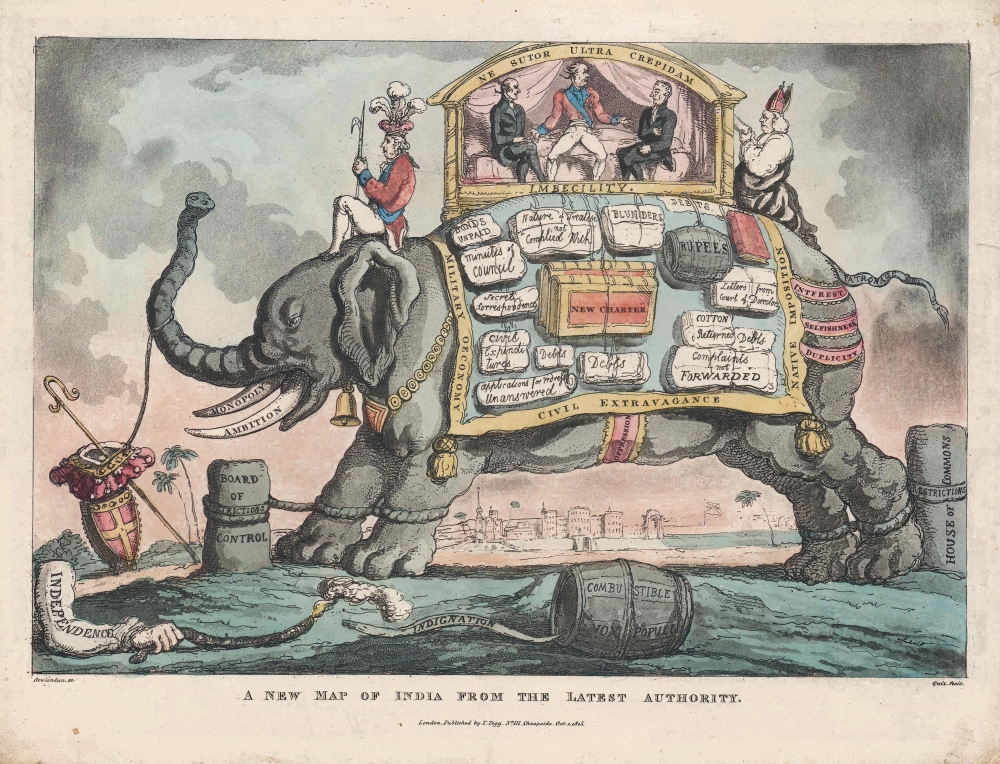1815 Tegg Satirical Cartoon, British in India
India-tegg-1815
Title
1815 (dated) 7.5 x 10.75 in (19.05 x 27.305 cm)
Description
A Closer Look
Forty years before the Indian Mutiny, Rowlandson's cartoon points out many of the problems leading to intense dissatisfaction in India, including the questionable practices of the EIC. As if predicting future events, a severed arm holds a match near a trail of gunpowder labeled 'indignation,' issuing forth from a barrel with the words 'Combustible, Vox Populi.' In fact, the excesses of Company Rule in India were already jeopardizing its own existence. The Vellore Mutiny in 1806 was nearly a test run of the mutiny fifty years later, and additional mutinies broke out in 1817 and 1824.Dominating the image is an elephant representing India, draped with a saddle listing the misdeeds of the EIC - such as 'selfishness,' 'duplicity,' 'imbecility' - and mentions of its unpaid debts and bonds. The elephant's legs are shackled by restrictions imposed by the House of Commons and Board of Control, a reference to mercantilist policies that greatly disadvantaged Indian exports. Sitting atop the elephant on a sofa is Warren Hastings, the first Governor-General of Bengal (1772 - 1785) and one of the architects of British imperialism in India, who was impeached and put on trial in 1785 for embezzlement, extortion, and coercion. Though ultimately acquitted, the trial highlighted the unsavory and expansionist policies of the EIC, and, along with the independence of the United States of America, helped spur a debate about the nature and intentions of British imperial policies worldwide. (Edmund Burke, leading critic of British policies towards its American colonies, also harshly condemned the EIC.) Above Hastings' head is the Latin phrase 'Sutor, ne ultra crepidam,' implying that the EIC should have stuck to trading and was out of its league in trying to fight wars and administer territory.
The plume of feathers above the driver's head refers to George IV, Prince of Wales, who was ruling as Prince Regent due to his father, George III's, mental illness. The implication is that the crown is only a servant of the EIC. Indeed, the EIC maintained tremendous influence in British politics, and tussles over its outsize power raged throughout the 18th century. However, the company was in a sense a victim of its own success - as areas under 'British' authority grew in India and as Britain's trade with China expanded, the British government sought to exert more control to prevent abuses and conflicts. The company's trade monopoly was ended in 1813 and it transferred many of its assets in India to the British government to cover its debts, but it still managed to exert enough influence to have Parliament (narrowly) approve war against China in 1840 for the destruction of its Canton opium stores. Finally, with the Indian Mutiny in 1857, the company was nationalized, being dissolved shortly thereafter, and the British Raj instituted.
Growing British Dominance in India
This caricature was published at a time when Britain's supremacy in India had become well-established. In the second half of the 18th century, not only did the EIC displace any potential European competitors, but it also conquered or co-opted indigenous states and began to directly administer Bengal and other areas. This cartoon was drawn during and published soon after the Anglo-Nepalese War (1814 - 1816). In the following years and decades, the EIC would go to war against the Marathas, Sikhs, Burmese, and Afghans, facing temporary setbacks in some cases (especially Afghanistan) but nevertheless ultimately gaining direct or indirect control over their territories.Publication History and Census
This caricature was drawn by Thomas Rowlandson in 1815 and served as the frontispiece the book The grand master, or, Adventures of Qui Hi? in Hindostan a Hudibrastic Poem in Eight Cantos, published the following year by Thomas Tegg in London. The book's author, 'Quiz,' is presumed to be William Combe (1742 - 1823) a sharp satirical writer and frequent collaborator of Rowlandson. 'Qui hi' is the Anglicization of a Bengali phrase used to summon servants, which came to be a humorous and disparaging term applied to the British by other Europeans in India.The drawing is independently cataloged among the holdings of the Metropolitan Museum of Art and the British Museum, while the entire book (OCLC 4303735) is more widespread.
Cartographer
Thomas Rowlandson (July 13, 1757 - April 21, 1827) was a prolific English artist who specialized in caricatures and satirical works, as well as unpublished erotica. Born in London, Rowlandson showed both artistic skill and a cheeky streak from a young age. He studied at the Royal Academy from 1772 and spent two years in Paris honing his art skills. He was friends and contemporaries with caricaturists James Gillray and Henry William Bunbury. After some difficulties, Rowlandson found success collaborating with publisher Rudolph Ackermann and satirist William Combe. He helped to develop the character of John Bull, but generally avoided explicitly political caricature, opting instead for social and cultural commentary. More by this mapmaker...

